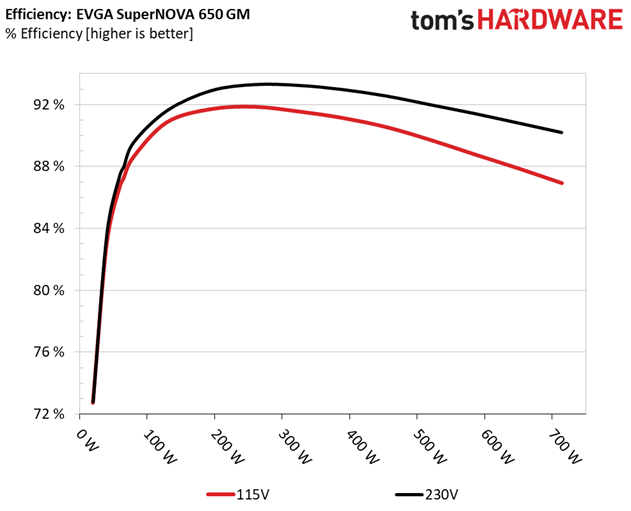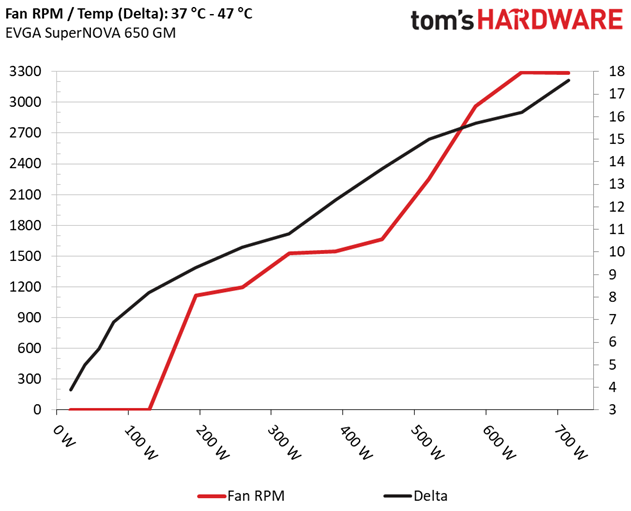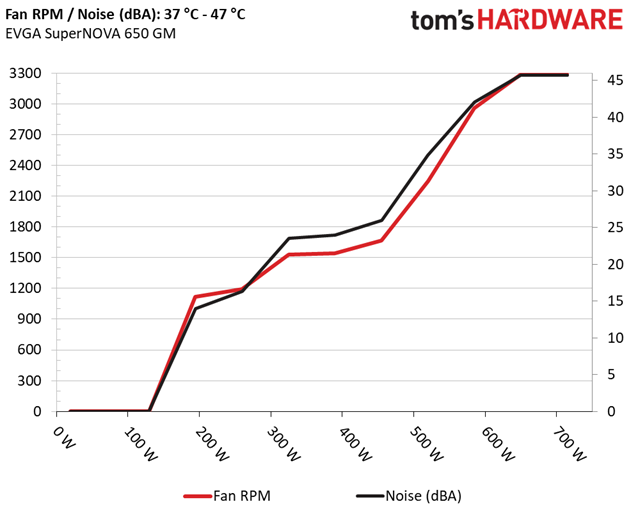EVGA SuperNOVA 650 GM PSU Review: Big Power In A Small Form Factor
Why you can trust Tom's Hardware
Efficiency, Temperature and Noise
Efficiency
Our efficiency testing procedure is detailed here.
Using results from the previous page, we plotted a chart showing the 650 GM’s efficiency at low loads, and loads from 10 to 110 percent of its maximum-rated capacity.




Overall efficiency looks good under multiple load scenarios. In fact, the 650 GM is actually in 80 PLUS Platinum territory, even though it's only 80 PLUS Gold-rated.
Efficiency At Low Loads
In the following tests, we measure the 650 GM's efficiency at loads significantly lower than 10 percent of its maximum capacity (the lowest load the 80 PLUS standard measures). The loads we dial are 20, 40, 60, and 80W. This is important for representing when a PC is idle, with power-saving features turned on.
| Test # | 12V | 5V | 3.3V | 5VSB | DC/AC (Watts) | Efficiency | Fan Speed | PSU Noise | PF/AC Volts |
|---|---|---|---|---|---|---|---|---|---|
| 1 | 1.197A | 0.491A | 0.486A | 0.197A | 19.534 | 72.739% | 0 RPM | <6.0 dB(A) | 0.696 |
| 12.052V | 5.098V | 3.294V | 5.093V | 26.855 | 115.05V | ||||
| 2 | 2.464A | 0.982A | 1.000A | 0.393A | 39.985 | 83.032% | 0 RPM | <6.0 dB(A) | 0.779 |
| 12.051V | 5.094V | 3.291V | 5.085V | 48.156 | 115.05V | ||||
| 3 | 3.657A | 1.473A | 1.489A | 5.079A | 59.464 | 86.729% | 0 RPM | <6.0 dB(A) | 0.838 |
| 12.050V | 5.092V | 3.288V | 5.079V | 68.563 | 115.05V | ||||
| 4 | 4.917A | 1.965A | 2.008A | 0.789A | 79.839 | 88.637% | 0 RPM | <6.0 dB(A) | 0.876 |
| 12.048V | 5.089V | 3.285V | 5.072V | 90.074 | 115.05V |
The efficiency we calculate under light loads looks great. Even with less than 20W, the platform is more than 70% efficient. In the other three tests, EVGA's 650 GM breaks the 80% threshold.
5VSB Efficiency
The ATX specification (revision 1.4), along with CEC, ErP Lot 3 2014 and ErP Lot 6 2010/2013, states that 5VSB standby supply efficiency should be as high as possible, recommending 75 percent or higher with 550mA, 1A, and 1.5A of load. The PSU should also achieve higher than 75% efficiency at 5VSB under full load, or with 3A if its max current output on this rail is higher than 3A.
We take six measurements: one each at 100, 250, 550, 1000, and 1500mA, and one with the full load the 5VSB rail can handle.
Get Tom's Hardware's best news and in-depth reviews, straight to your inbox.
| Test # | 5VSB | DC/AC (Watts) | Efficiency | PF/AC Volts |
|---|---|---|---|---|
| 1 | 0.100A | 0.500 | 72.886% | 0.069 |
| 4.998V | 0.686 | 115.05V | ||
| 2 | 0.250A | 1.249 | 79.554% | 0.149 |
| 4.995V | 1.570 | 115.05V | ||
| 3 | 0.550A | 2.745 | 80.428% | 0.271 |
| 4.989V | 3.413 | 115.04V | ||
| 4 | 1.000A | 4.982 | 79.192% | 0.376 |
| 4.981V | 6.291 | 115.04V | ||
| 5 | 1.500A | 7.459 | 80.891% | 0.431 |
| 4.972V | 9.221 | 115.04V | ||
| 6 | 2.500A | 12.388 | 79.625% | 0.485 |
| 4.955V | 15.558 | 115.04V |


The 5VSB rail performs well, coming close to Corsair's older SF platform. The newer Platinum SF platform is notably better, though it also costs more.
Power Consumption In Idle And Standby
In the table below, you'll find the power consumption and voltage values of all rails (except -12V) when the PSU is idle (powered on, but without any load on its rails), and the power consumption when the PSU is in standby mode (without any load, at 5VSB).
| Mode | 12V | 5V | 3.3V | 5VSB | Watts | PF/AC Volts |
|---|---|---|---|---|---|---|
| Idle | 12.050V | 5.098V | 3.294V | 5.097V | 5.486 | 0.320 |
| 115.1V | ||||||
| Standby | 0.116 | 0.012 | ||||
| 115.1V |


Power consumption in standby is elevated. That's a shame because it affects the 5VSB rail's efficiency under light loads.
Fan RPM, Delta Temperature, And Output Noise
Our mixed noise testing is described in detail here.
The first chart below illustrates the cooling fan's speed (in RPM), and the delta between input and output temperature. The results were obtained at 37°C (98.6°F) to 47°C (116.6°F) ambient temperature.
The next chart shows the cooling fan's speed (again, in RPM) and output noise. We measure acoustics from one meter away, inside a hemi-anechoic chamber. Background noise inside the chamber is below 6 dB(A) during testing (it's actually much lower, but our sound meter’s microphone hits its floor), and the results are obtained with the PSU operating at 37°C (98.6°F) to 47°C (116.6°F) ambient temperature.
The following graphs illustrate the fan's output noise and speed over the PSU's operating range. The same conditions of the above graph apply to our measurements, though the ambient temperature is between 30°C (86°F) to 32°C (89.6°F).
Semi-passive operation lasts up to the 150W load level, and the fan spins slowly at up to 440W. Above 530W, the PSU's noise exceeds 35 dB(A).
MORE: Best Power Supplies
MORE: How We Test Power Supplies
MORE: All Power Supply Content
Current page: Efficiency, Temperature and Noise
Prev Page Load Regulation, Hold-Up Time and Inrush Current Next Page Protection Features and DC Power Sequencing
Aris Mpitziopoulos is a contributing editor at Tom's Hardware, covering PSUs.



